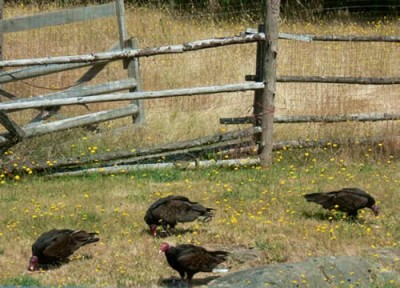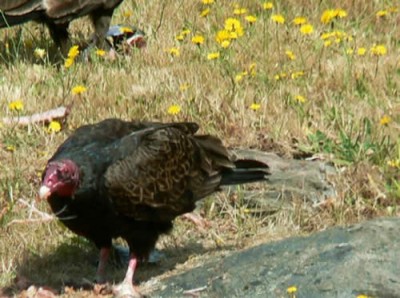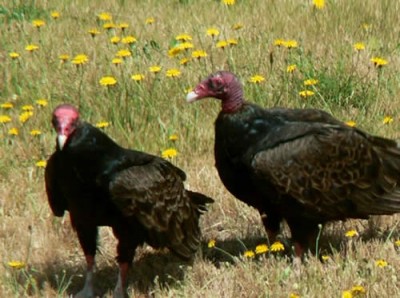Photos taken at Annie’s Acres
(click any of the images below for a larger version)
The Turkey Vulture is probably one of Gabriola Island’s least appreciated and most misunderstood residents. Their strange appearance is bound to conjure up feelings of fear and disdain, but the turkey vulture has many interesting and redeeming qualities.
They are a peaceful bird, they mate for life, both male and female participate in raising their young and they live and travel in large groups called “venues.” The Cherokee nation honours them with the name “Peace Eagle.”
 The Turkey Vulture plays the role of sanitary engineer in our eco system. They never eat live prey. Their primary food source is carrion or in less glamorous terms, “road kill”. In fact, Dianne MacRae, noted expert on Turkey Vultures, entitled an article in the Beautiful BC Magazine “Vulture Culture: The Ultimate Roadside Diner.” In addition to carrion, they occasionally dine on vegetation and small invertebrates.
The Turkey Vulture plays the role of sanitary engineer in our eco system. They never eat live prey. Their primary food source is carrion or in less glamorous terms, “road kill”. In fact, Dianne MacRae, noted expert on Turkey Vultures, entitled an article in the Beautiful BC Magazine “Vulture Culture: The Ultimate Roadside Diner.” In addition to carrion, they occasionally dine on vegetation and small invertebrates.
Because their digestive systems are so strong, bacteria is killed in the process of digestion and their feces contain so much uric acid that it acts as a disinfectant. Warning – these birds defend themselves from predators by regurgitating and send most invaders running from the terrible smell.
 The Turkey vulture has many unique qualities that set it apart from other birds. It is one of a few birds in North American that has a strong sense of smell. It is said that they can smell mercapton, the gas generated from rotting, for up to 1.5 kilometers.
The Turkey vulture has many unique qualities that set it apart from other birds. It is one of a few birds in North American that has a strong sense of smell. It is said that they can smell mercapton, the gas generated from rotting, for up to 1.5 kilometers.
This majestic bird is one of the largest birds in North America. Its wingspan can reach up to 6 feet and its body length ranges from 25 to 32 inches.
The turkey vulture’s very small bald red head certainly doesn’t seem to fit with its majestic body, but is extremely useful for scavenging. It allows them to go deep into a carcass for food without getting its head dirty.
The turkey vulture does not have a “voice box”. They communicate with hisses or grunts. They do not have a nasal septum separating the two nostrils like most animals so you can see from one nostril to the other side.
One of the major factors separating the Old World Vultures – found in Africa, Asia and Europe, and the New World Vultures is their inability to grasp or carry away food with their feet. They have small “chicken like” feet and are forced to eat their dinners where they find it.
In flight, the Turkey Vulture is one the most graceful and beautiful soaring birds in the world. They follow thermals of warm rising air and can soar for hours without flapping their wings. Pilots have reported seeing them soaring as high as 6000 feet. When you look skyward they are easily identified because they hold their wings in dihedral or “V” shape, while other large birds hold their wings straight out and flap. A group of soaring Turkey Vultures is known as a “kettle” of Vultures.
 The Turkey Vulture makes its home on Gabriola from March to October. When they fly south for the winter, hundreds of vultures congregate at the southern tip of Vancouver Island in the Becher Bay headlands near Sooke Park. Because they rely on thermals to fly, they may wait up to three weeks for the right weather to cross the 21 kilometers of the Juan de Fuca Strait and then southward.
The Turkey Vulture makes its home on Gabriola from March to October. When they fly south for the winter, hundreds of vultures congregate at the southern tip of Vancouver Island in the Becher Bay headlands near Sooke Park. Because they rely on thermals to fly, they may wait up to three weeks for the right weather to cross the 21 kilometers of the Juan de Fuca Strait and then southward.
For more information go to http://vulturesociety.homestead.com
